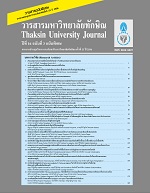ผลของการดัดแปรกากมะพร้าวด้วยวิธีทางกายภาพต่อสมบัติทางเคมีกายภาพและประสิทธิภาพการย่อยคาร์โบไฮเดรตในหลอดทดลองของปลาเศรษฐกิจ
Main Article Content
Abstract
การวิจัยนี้เป็นการศึกษาผลของการแช่น้ำ การใช้คลื่นไมโครเวฟ การฉายรังสีแกมมา และการฉายลำแสงอิเล็กตรอนต่อการเปลี่ยนแปลงสมบัติทางเคมีกายภาพของกากมะพร้าว และศึกษาประสิทธิภาพการย่อยคาร์โบไฮเดรต ในหลอดทดลองโดยใช้เอนไซม์ที่สกัดจากปลานิล (Oreochromis niloticus) จากการศึกษาพบว่า การดัดแปรมีผลอย่างมี นัยสำคัญต่อการลดลงของเยื่อใย ในขณะที่ปริมาณคาร์โบไฮเดรตที่ย่อยได้มีค่าเพิ่มขึ้น (P < 0.05) สมบัติทางเคมี กายภาพ ได้แก่ โครงสร้างทางจุลภาค และความเป็นผลึก มีการเปลี่ยนแปลงหลังจากผ่านการดัดแปร เมื่อทดสอบ ประสิทธิภาพการย่อยคาร์โบไฮเดรตในหลอดทดลองพบว่า กากมะพร้าวที่ผ่านการดัดแปรโดยวิธีแช่น้ำและใช้คลื่น ไมโครเวฟมีประสิทธิภาพการย่อยในหลอดทดลองสูงสุด รองลงมาคือ การฉายลำแสงอิเล็กตรอนและรังสีแกมมา ตามลำดับ ดังนั้น การดัดแปรกากมะพร้าวด้วยการแช่น้ำหรือใช้คลื่นไมโครเวฟจึงสามารถเพิ่มประสิทธิภาพการใช้ ประโยชน์จากคาร์โบไฮเดรตของปลาเศรษฐกิจได้
Effects of Physical Modification of Coconut Meal on Physicochemical Property and In Vitro Carbohydrate Digestibility in Economic Fish
Sunetra Chumwaengwapee1 Sarisak Soontornchai2* and Karun Thongprajukeaw3
This research aimed to study effects of water soaking, microwave irradiation, gamma irradiation and electron beam on physicochemical property of coconut meal and in vitro carbohydrate digestibility by using digestive enzymes from Nile tilapia (Oreochromis niloticus). The result showed that modified methods had significant effects by decreasing crude fiber and increasing available carbohydrates (P < 0.05). Physicochemical properties including microstructure and crystallinity were altered after modification. The highest in vitro carbohydrate digestibility values were observed in soaked and microwave-irradiated coconut meals, followed by electron beam and gamma irradiation, respectively. Therefore, soaking or microwave irradiation could be used for increasing efficiency of carbohydrate digestibility in economic fish.


